How Japan Prepares Chicken and Beef
This post may contain chapter links. Please read my disclosure policy for details. As an Amazon Acquaintance, I earn from qualifying purchases.
Yosenabe is a bones Japanese hot pot where yous can cook any ingredients—chicken, seafood, tofu, and all kinds of vegetables—in a delicious dashi-based broth.
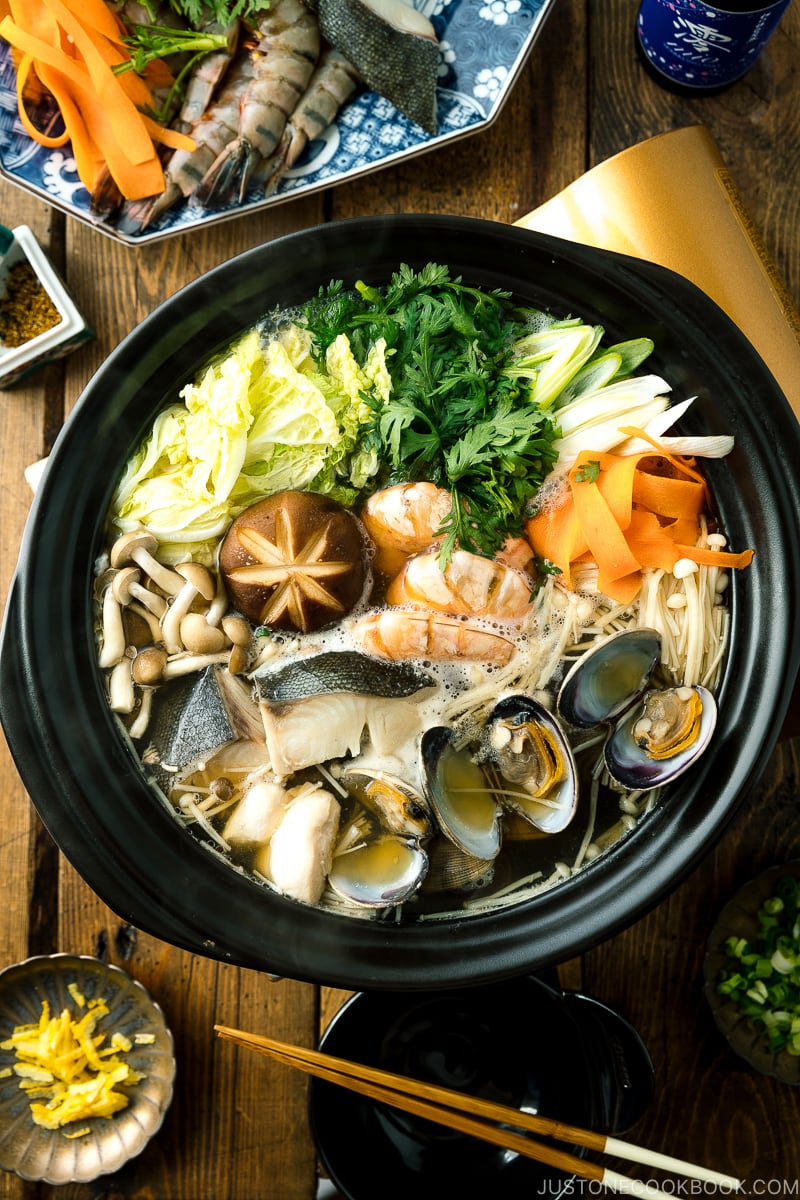
Looking for a flexible hot pot recipe that tin can make clean upwards leftover vegetables or meat in the freezer drawer? Y'all'll have to attempt Yosenabe (寄せ鍋) or "Anything Goes" Hot Pot! This popular Japanese hot pot is a wintertime favorite to make at abode because you tin can literally throw in just about anything. It'southward a warm, flavorful, and easy meal to kicking.
Y'all tin can go along things simple for a weeknight dinner, but with the addition of fresh seafood, yosenabe can easily be i of the almost luxurious hot pots to serve at a gathering!
What is Yosenabe?
The word yose comes from the verb yoseru (寄せる) which means to "put together." And nabe (鍋) is the Japanese word for "pot" and is used to refer to hot pot dishes. So yosenabe is pretty much an "everything hot pot" where you have all kinds of ingredients cooked together in a simmering broth for an ultimate warm meal.
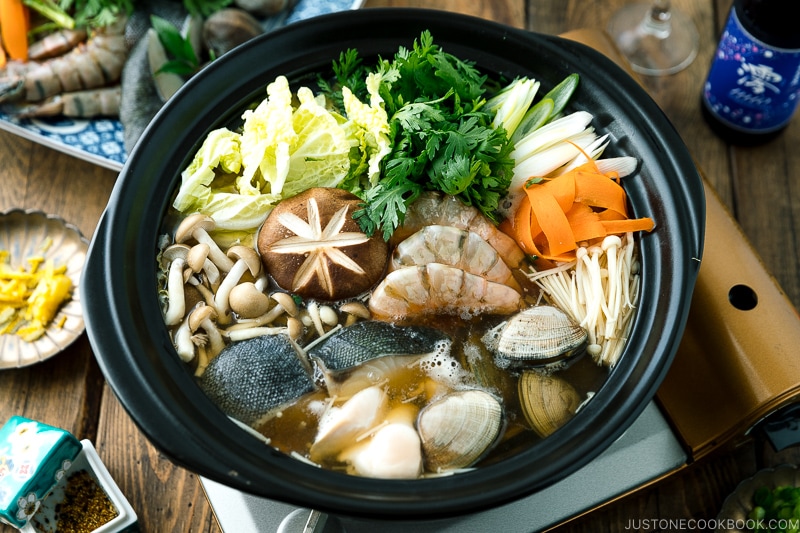
I also telephone call yosenabe a freestyle hot pot because there is no correct or wrong way to brand it. You outset with a simple dashi broth, then add in your option of proteins, followed by fresh vegetables and mushrooms. For yosenabe, the more than the merrier. The mix of ingredients will lend plenty of flavor to the soup broth!
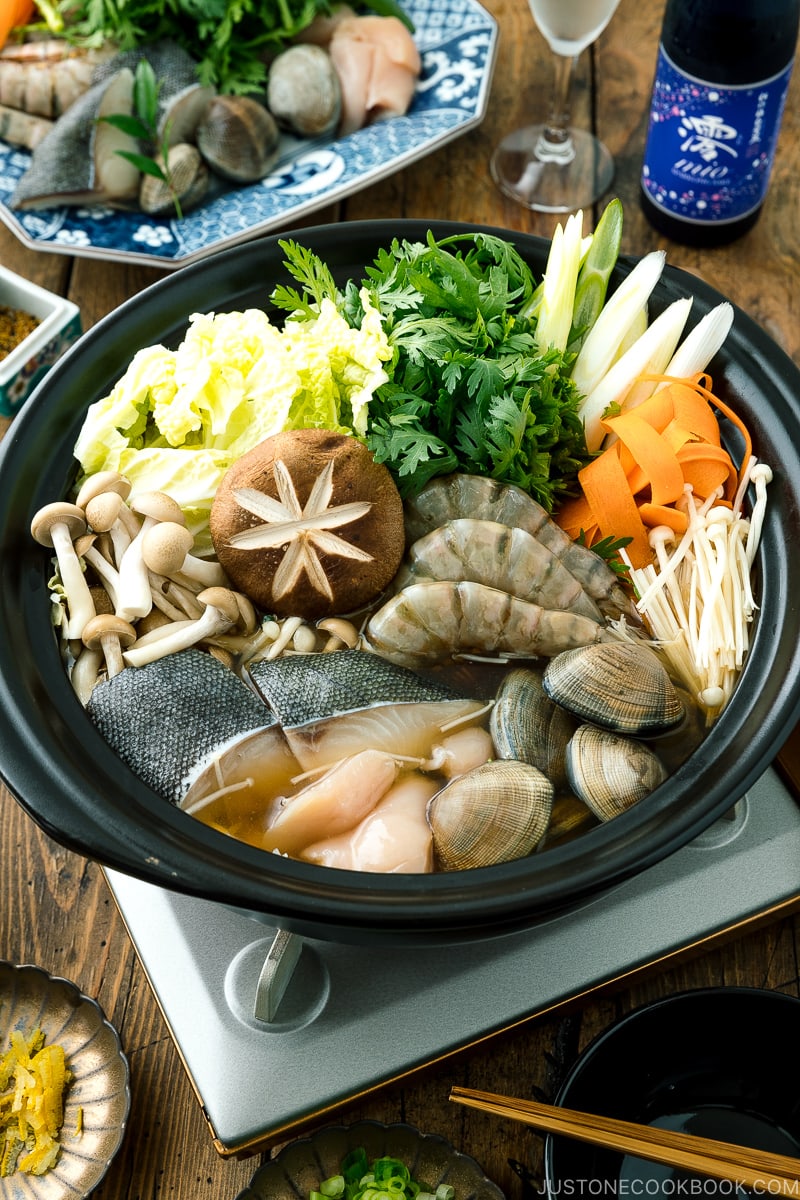
How to Prepare Yosenabe
Ingredients You'll Need
- Meat: craven tender, just can exist chicken thighs or any other meat you lot enjoy
- Seafood: sablefish, shrimp, and Manila clams, but scallops and mussels work fine too
- Vegetables: napa cabbage, chrysanthemum leaves, carrot, and negi
- Mushrooms: shiitake, shimeji, and enoki mushrooms
- Tofu: medium firm tofu
- Goop: awase dashi (kombu + katsuobushi broth)
- Seasonings: sake, mirin, soy sauce, and salt
- Garnish: green onion, yuzu zest, and shichimi togarashi
Overview: Prepping Steps
- Make broth.
- Prepare seafood and meat.
- Cut vegetables and mushrooms.
Cooking Tools for Hot Pot
- A large donabe (Japanese earthenware pot) – Yous can also use a large Dutch oven. I have unlike styles of donabe and for this recipe, I used Ginpo Kikka Banko Donabe Japanese Dirt Pot. If you lot beloved hot pot dishes (shabu shabu, sukiyaki, kimchi nabe, etc.), information technology's a peachy kitchen tool to have!
- A portable stove – I utilise this Iwatani propane gas stove. It is a necessary tool to savor all kinds of hot pots at home.
- Communal cooking tools – Long cooking chopsticks, slotted spoons, ladles, and a fine-mesh skimmer.
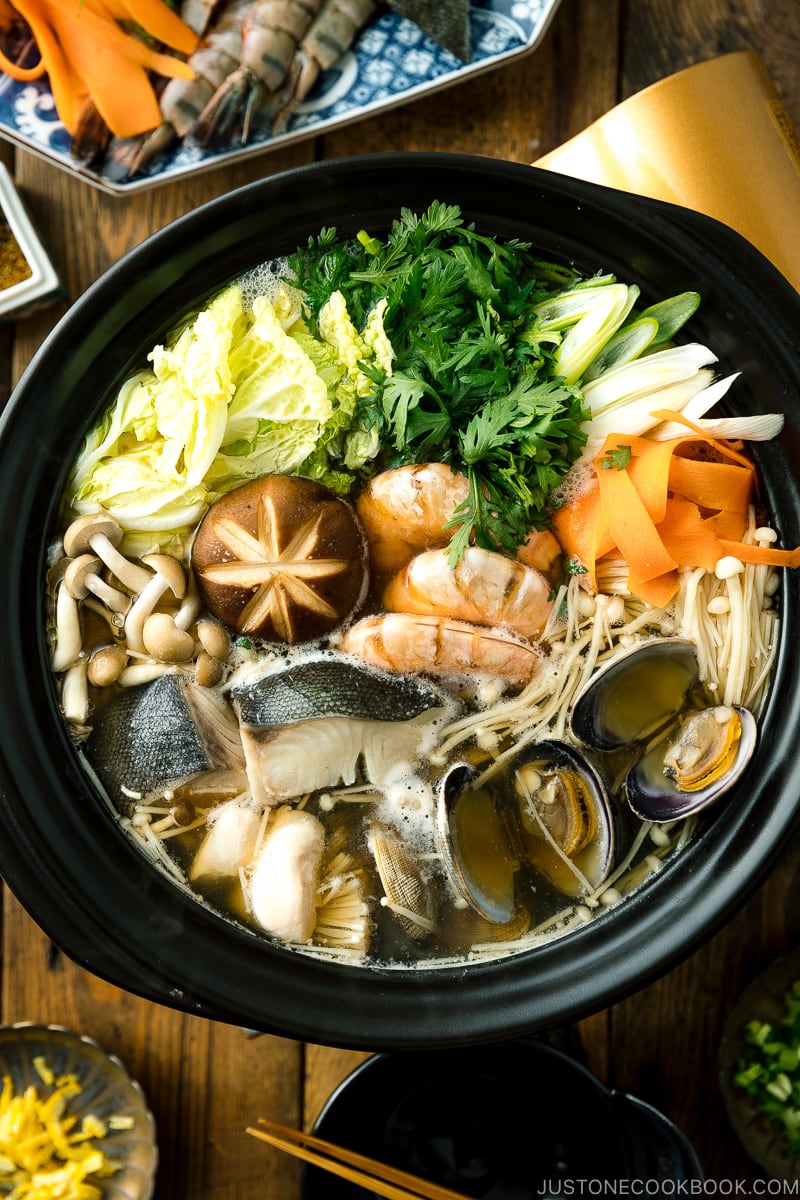
Mirin and Sake I Recommend
To flavour the soup broth, yous will need mirin and sake. Merely like soy sauce, these two condiments are oftentimes used in Japanese recipes. It'due south very important to use mirin with a higher % of booze, and not a mirin-similar or mirin-type condiment (read more about unlike kinds of mirin).
Sake is almost always used whenever we make seafood and meat recipes as the alcohol masks the fishy/gamey odor while imparting sweetness natural umami from the fermented rice wine.
I've been using Sho Chiku bai Archetype Junmai and Takara Mirin by Takara Sake for a long time. And I'm glad that I become to partner with the company to introduce the trusted Japanese ingredients to elevate your cooking!
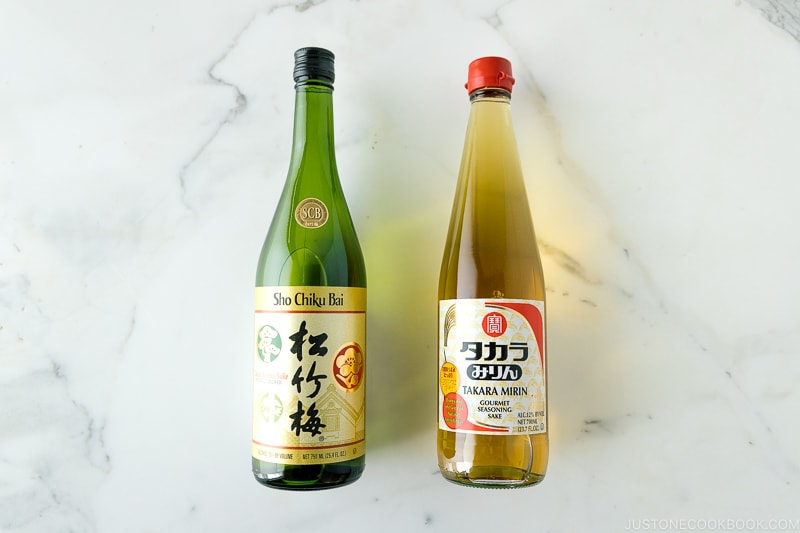
You can purchase Sho Chiku bai Classic Junmai and Takara Mirin at Japanese grocery stores, Asian grocery stores, and some local supermarkets.
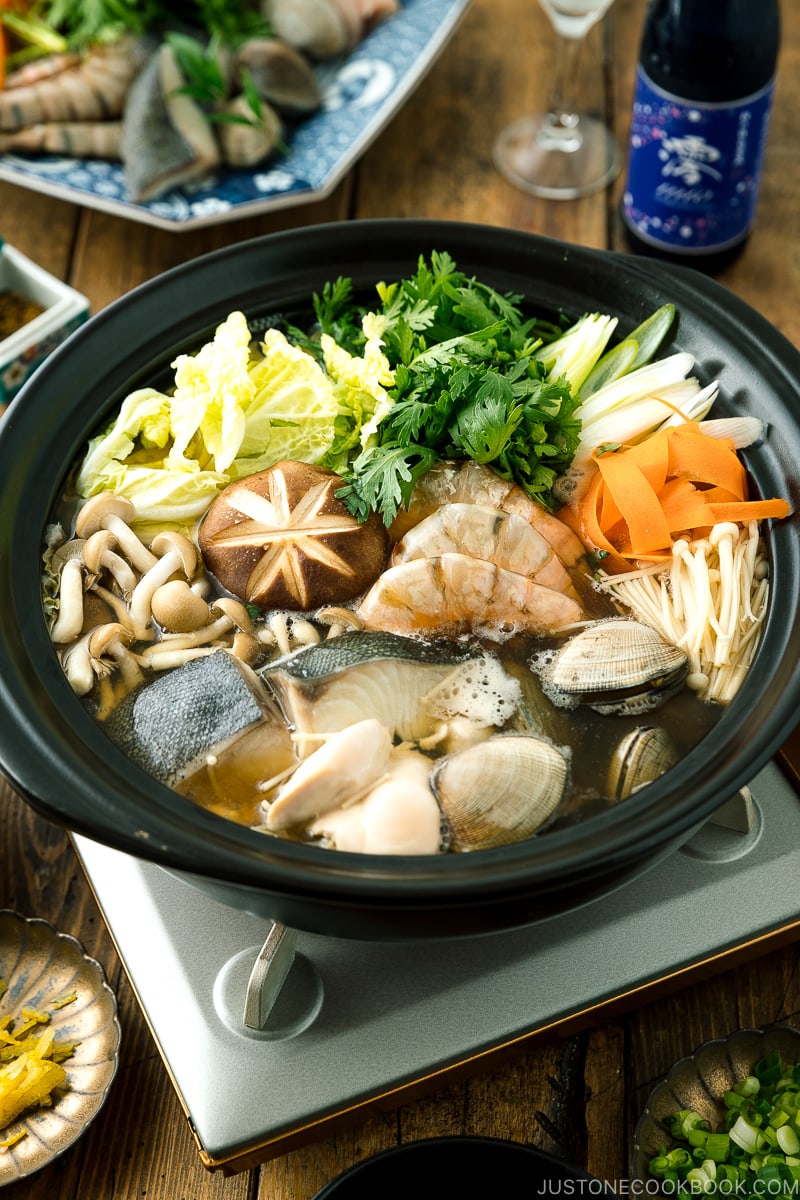
How To Cook Yosenabe At The Table
Step 1: Set up the table
In the center of the table, set up a portable stove for the hot pot. Make certain everyone can reach the pot; otherwise, I recommend setting upward more than than one stove and pot. It's not fun when you sit too far from the hot pot action.
Identify the platters of ingredients around the portable stove. They should exist easily attainable to everyone.
Step two: Bring the broth to a boil
First, bring the broth to a boil. If y'all are cooking root vegetables such equally daikon, gobo (burdock root), and carrots (if not ribbons, as I did in this recipe), start cooking them while you are heating up the broth. They have a longer time to cook.
Step 3: Fill the pot with ingredients but do not overcrowd
Once the broth is boiling, add the ingredients to the pot by arranging them past sections until the pot is filled. For example, go along the napa cabbage in one surface area, while the mushrooms stay in ane area and seafood stay in another. This way, it'due south easy to selection upwards the nutrient you desire to eat.
Always call up—do not overcrowd as we will melt and consume in batches. Hot pot is a process, so space out the cooking then y'all can enjoy the food at a leisurely pace.
Close the lid and melt for 8-10 minutes. Depending on the ingredients, leafy greens will cook a lot faster than chicken, so keep an heart out on the nutrient. During the waiting period, everyone tin enjoy any appetizers or side dishes that are served alongside the hot pot.
Step 4: Serve the cooked food
Information technology's e'er a prissy gesture to pick up foods from the pot for people sitting next to y'all who may be busy chatting or eating. Enquire if they are interested in being served.
Enjoy the food while hot. For yosenabe, the ingredients are already cooked in a flavorful goop, so there's no demand for a dipping sauce. We sprinkle chopped green onion, yuzu zest, and/or shichimi togarashi to enjoy.
Step 5: Start a new batch
Once all the cooked nutrient is served and cleared from the hot pot, add a new batch of ingredients. Cover the lid and start cooking for another viii-10 minutes. Add together water if the goop is depression in the pot. Enjoy and continue with 2-three more rounds of cooking until you finish all the ingredients.
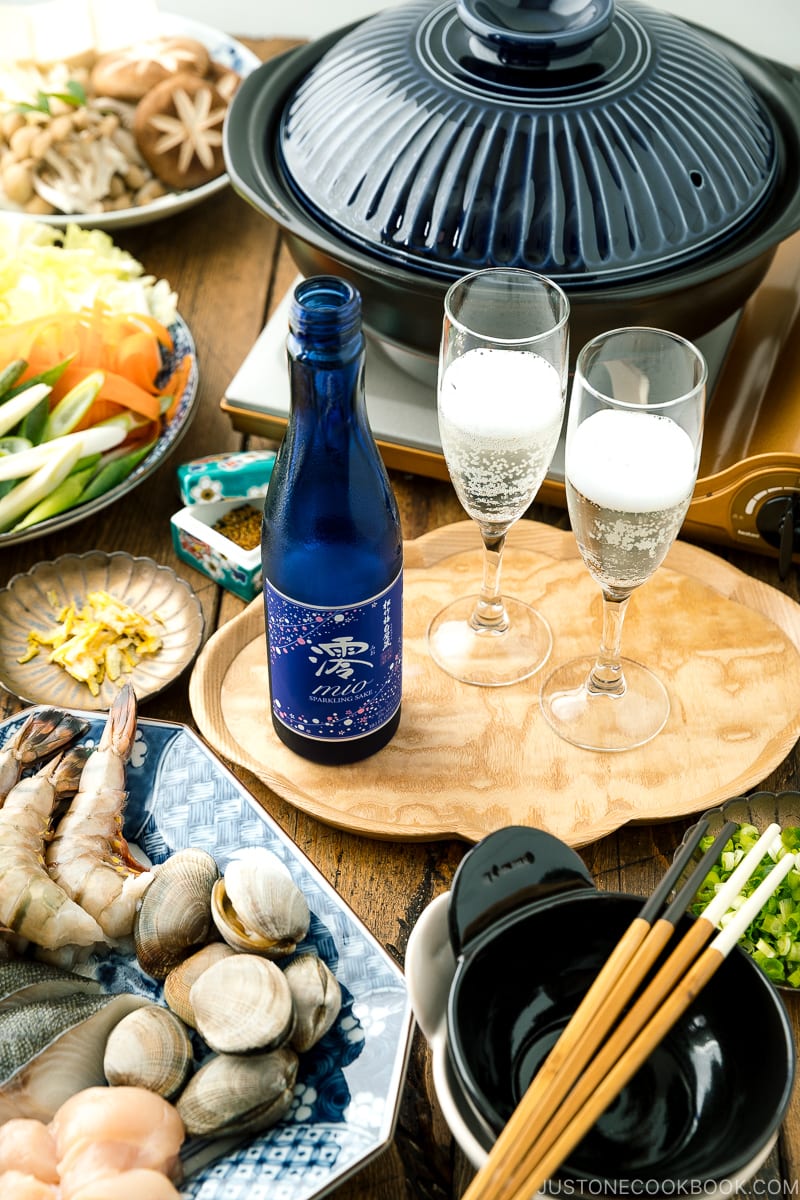
Sake Pairing with Mio
For yosenabe, we've paired information technology with Takara Sake's Sho Chiku Bai Shirakabegura Mio. It is ane of our favorite sake drinks to share with friends and bask during celebrations.
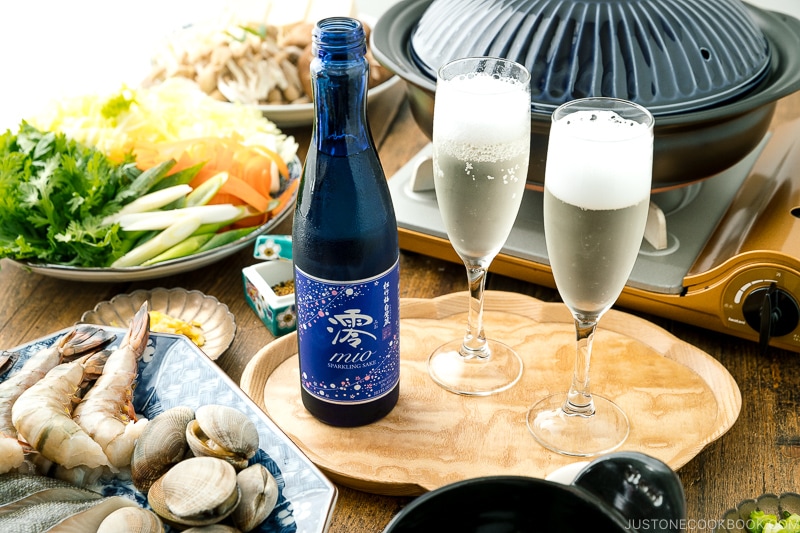
If you've never tried sparkling sake before, we would highly recommend trying Mio equally the starting time one. It is made from just rice and koji rice with no additives. The contour is slightly sweetness, fruity, and very refreshing. Many of our friends were surprised how delicious it tastes and became instant fans. Its tiny bubbles are similar in texture to a fine champagne and contains a low 5% alcohol compared to regular sakes.
The gentle characters of Mio complement yosenabe's assuming savory flavors superbly. Drinking the sparkling sake while eating hot pot brings out the unique flavors of each ingredient, and Mio ends up tasting a bit sweeter with the savory foods. The best role is the cold sparkling sake cools you downward and encourage the appetite to swallow more than hot pot!
Tableware from Musubi Kiln
I've partnered with a great ceramic online shop from Nihon calledMusubi Kiln. You lot volition get10% off with a coupon codeJUSTONECOOKBOOK for your purchase. In this post, I've used:
- Ginpo Kikka Banko Donabe Japanese Clay Pot for 3 to 4 persons
- Bronze Chrysanthemum Hasami Sauce Plate
- Seikou Kiln Kutani Traditional Pattern Small-scale Box
- Ichikawa Forest Craft Deject Shaped Wooden Tray
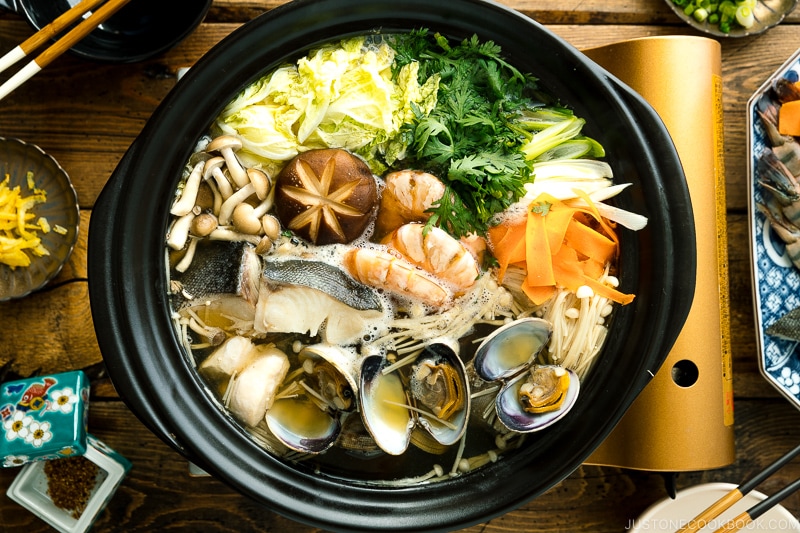
Wish to learn more almost Japanese cooking?Sign up for our gratuitousnewsletter to receive cooking tips & recipe updates! Andstay in touch with me on Facebook, Pinterest, YouTube, and Instagram.
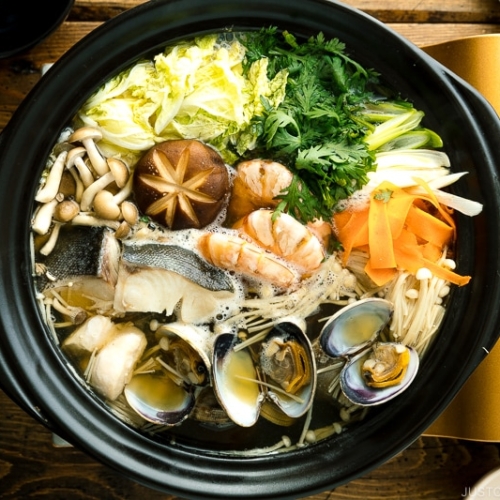
Yosenabe (Japanese Hot Pot)
Yosenabe is a bones Japanese hot pot where you tin can cook whatever ingredients—chicken, seafood, tofu, and all kinds of vegetables—in a delicious dashi goop.
Servings: four
Prevent your screen from going dark
For Yosenabet Ingredients
- x manila clams (11.4 oz, 325 yard; it's very important to follow this instruction to prepare clams)
- 8 shrimp (8.8 oz, 250 g)
- four fillets blackness cod/sablefish (gindara) (1 lb, 454 g)
- chicken tenders (4.half dozen oz, 130 1000)
- ½ piece napa cabbage (ane.4 lb, 628 thousand)
- ½ bunch shungiku (tong ho/garland chrysanthemum) (4 oz, 125 1000)
- 1 carrot (ii oz, lx thousand)
- 1 Tokyo negi (naga negi; long green onion) (1.4 oz, 40 g)
- 1 agglomeration enoki (vi oz, 170 yard)
- ane shimeji mushrooms (3.5 oz, 100 grand)
- four shiitake mushrooms (3.ii oz, 90 g)
- 1 medium-firm tofu (momen dofu) (14 oz, 397 k)
Japanese Ingredient Commutation: If you lot want substitutes for Japanese condiments and ingredients, click here.
To Prepare Yosenabe Broth
-
Gather all the ingredients.
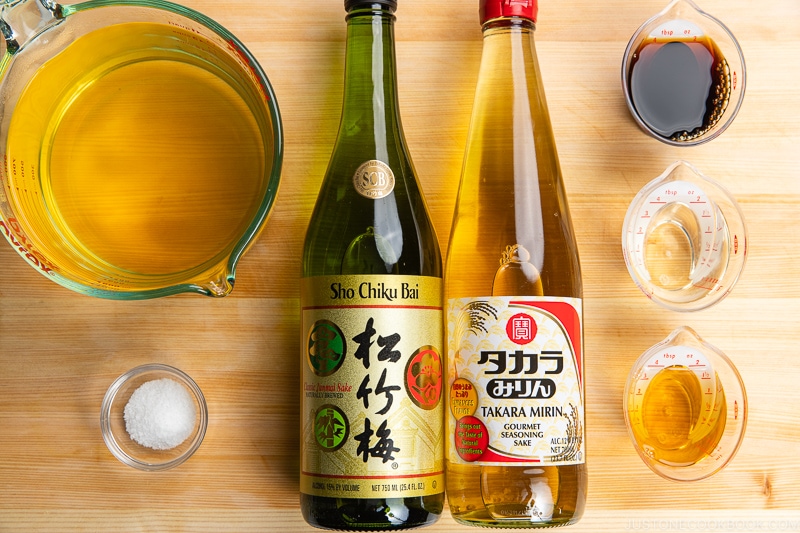
-
In a big pot (I used this donabe), combine dashi, sake, mirin, soy sauce, and table salt. Embrace and bring it to a simmer, and then turn off the heat. Set aside.
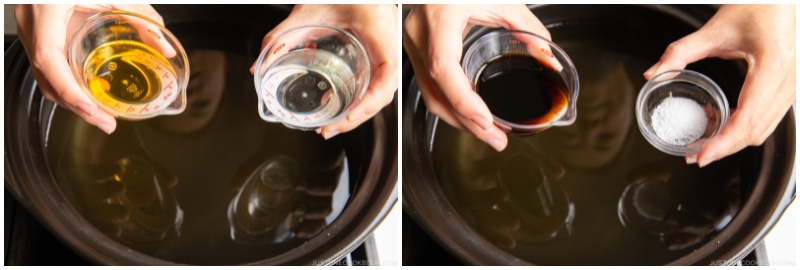
To Fix Ingredients
-
Gather all the ingredients. Yosenabe is pretty flexible and y'all tin substitute any of the listed ingredients with whatsoever you have or want to swallow.
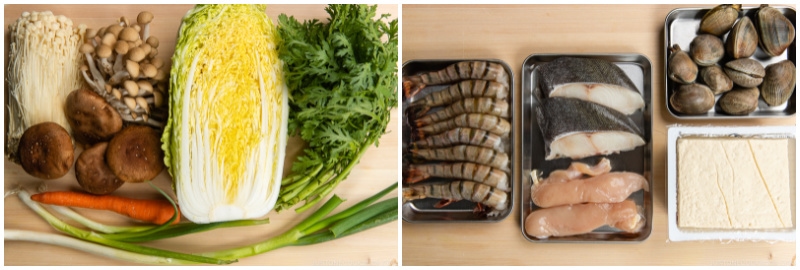
-
Shrimp: Devein shrimp past following this instruction. Insert the tip of the skewer sideways almost ½ inch (1.iii cm) downwards from the head of the shrimp (whether it'south a shell on or off) and pull the skewer tip upward towards yous. This will lift up the vein and you tin can pull it off with the skewer or with your hand. If the vein is cleaved, then insert again a bit lower towards the tail. If you lot can't notice the vein, so don't worry about it.
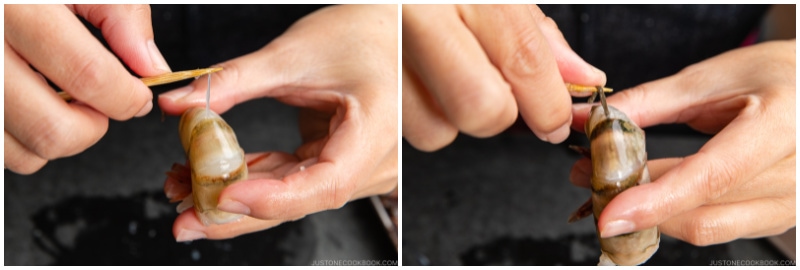
-
Chicken tender: To remove the tendon, firmly grab the end of the tendon (maybe use a paper towel to increment grip) and place the knife on top of the tendon every bit you run across in the image beneath. Using the pocketknife to hold the craven in place, pull the end of the tendon as yous push the chicken away. Repeat with the balance of the chicken tenders. And then concord your knife diagonally, nearly parallel to the cut lath, and and so slice the tender. This cutting method gives it more than area so that it cooks faster and soaks up flavor quickly. This cutting technique is called sogigiri in Japanese.
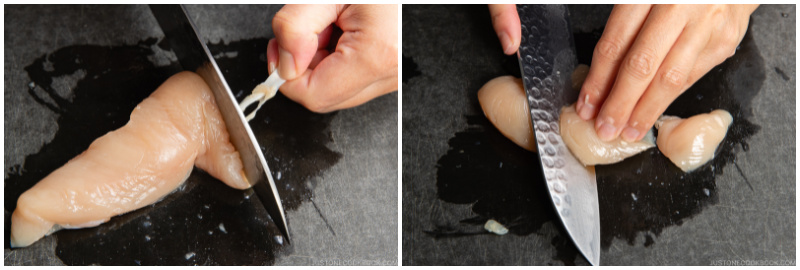
-
Fish: Cut the fish fillets in one-half. Place all the seafood ingredients on a platter.
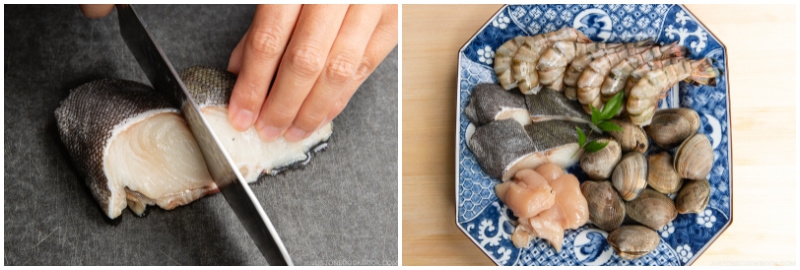
-
Napa cabbage: Remove the cadre, separate the leaves, and rinse them carefully. And so cut them into two-inch (5 cm) pieces.
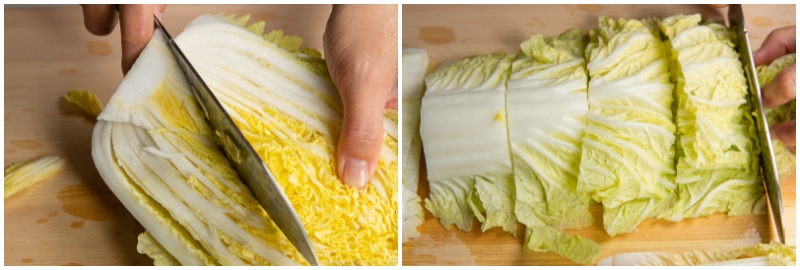
-
Cut the tough lesser part of the leaves into smaller strips/pieces.
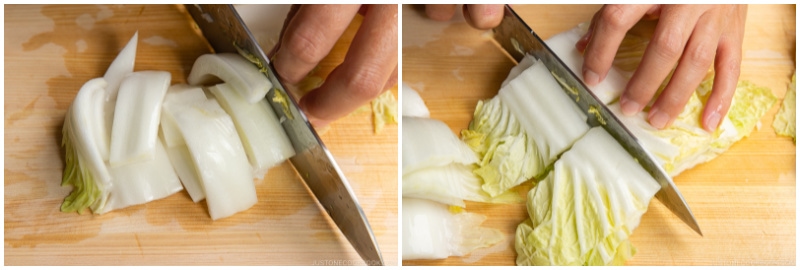
-
Chrysanthemum leaves: Cut them into 2-inch (5 cm) pieces. Negi: Cut it diagonally into ½-inch (1.3 cm) pieces.
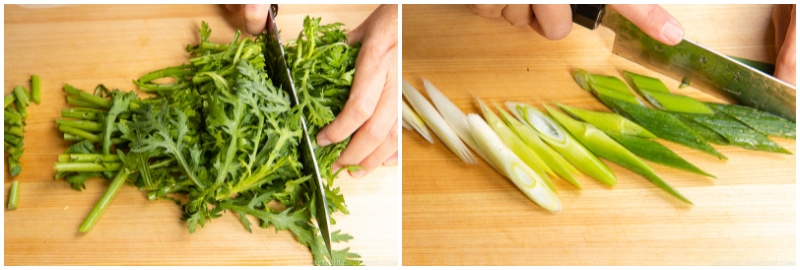
-
Carrot: Using a vegetable peeler, peel the carrot into thin ribbons. Place all the vegetables on another platter.
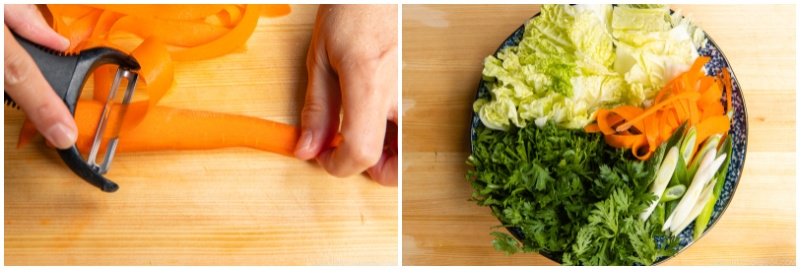
-
Enoki mushrooms: Discard the lesser and cut into two-inch (5 cm) pieces. Shimeji mushrooms: Discard the lesser and separate them.
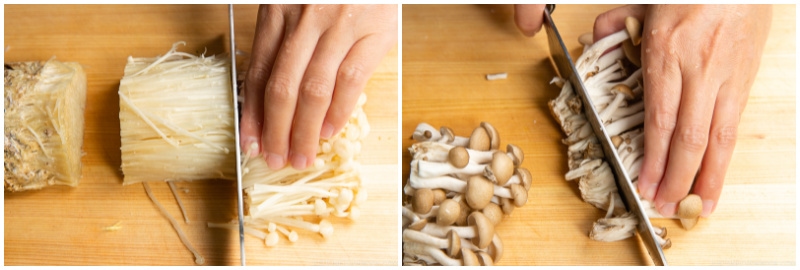
-
Shiitake mushrooms: Discard the bottom. If yous similar, you can curve the cap of shiitake mushrooms to make them look like a bloom by following this instruction.
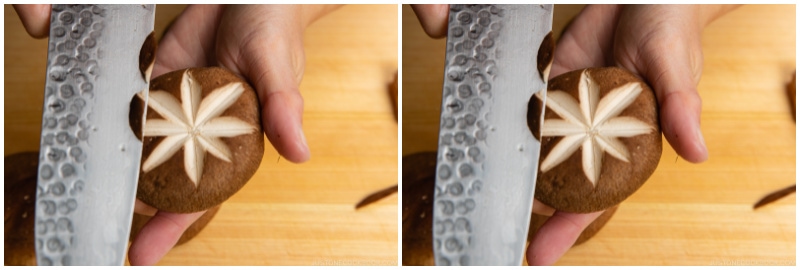
-
Tofu: Cut information technology into smaller pieces. Place the mushrooms and tofu on another platter.
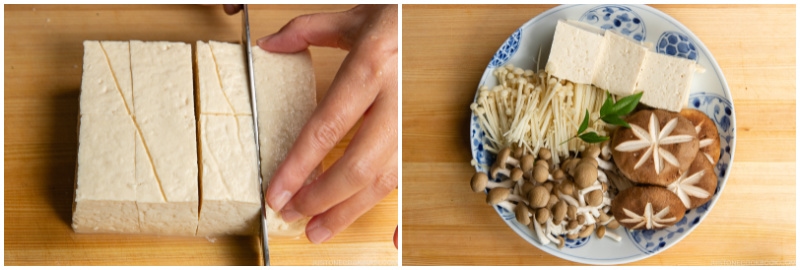
-
Green onion: Cut it into minor pieces for garnish.
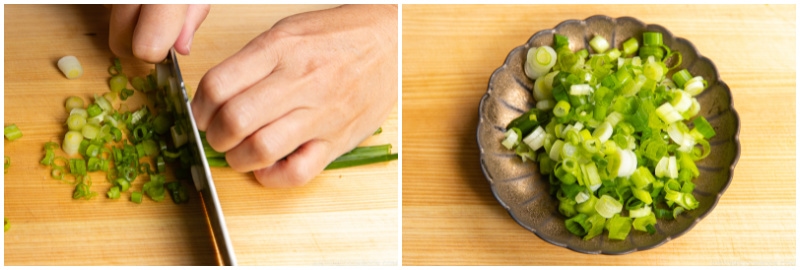
To Cook Yosenabe
-
Bring the broth to a boil. If y'all are cooking root vegetables such equally daikon, gobo (burdock root), and carrots (if not ribbons), start cooking them while you are heating up the goop. They take a longer fourth dimension to melt. In one case boiling, add together various kinds of ingredients to the pot and adjust them by sections. For case, grouping the napa cabbage in 1 area, while mushrooms stay in one area and seafood in some other. This way, you can cull what y'all want to eat. Shut the lid and cook for viii-10 minutes. Keep an heart on leafy greens. Dish them out early if they turn soft and fix to eat.

-
Pick up the cooked nutrient and enjoy while they are hot. For yosenabe, the ingredients are cooked in a flavorful goop; therefore, we practice non dip the cooked food in a dipping sauce like shabu shabu. Nosotros sprinkle chopped dark-green onion, yuzu zest, and/or shichimi togarashi to enjoy.

-
Once all the cooked ingredients are served and cleared from the hot pot, add together a new batch of ingredients. Cover the lid and showtime cooking for ten minutes. Add water if the broth is low in the pot.
-
Enjoy and repeat 1-2 more rounds until you finish all the ingredients.
To Store
-
You lot can proceed the leftovers in an airtight container and store them in the refrigerator for up to 2 days.
Calories: 318 kcal · Carbohydrates: twenty g · Poly peptide: 41 g · Fat: 7 g · Saturated Fat: 1 thousand · Polyunsaturated Fat: iii one thousand · Monounsaturated Fatty: ii g · Trans Fat: i thou · Cholesterol: 78 mg · Sodium: 1213 mg · Potassium: 1297 mg · Cobweb: 7 m · Sugar: 8 1000 · Vitamin A: 3310 IU · Vitamin C: 53 mg · Calcium: 316 mg · Iron: 4 mg
Course: Main Form
Cuisine: Japanese
Keyword: hot pot, seafood
©JustOneCookbook.com Content and photographs are copyright protected. Sharing of this recipe is both encouraged and appreciated. Copying and/or pasting total recipes to any website or social media is strictly prohibited. Please view my photo use policy here.
If you fabricated this recipe, snap a motion-picture show and hashtag it #justonecookbook! We love to see your creations on Instagram @justonecookbook!
Subscribe Now!
5 Secrets to Japanese Cooking: Uncomplicated Meals & Authentic Flavors!
Sign upwards to receive our FREE email serial on Japanese cooking tips and weekly newsletter.
nelsonoursend1939.blogspot.com
Source: https://www.justonecookbook.com/yosenabe/
Postar um comentário for "How Japan Prepares Chicken and Beef"